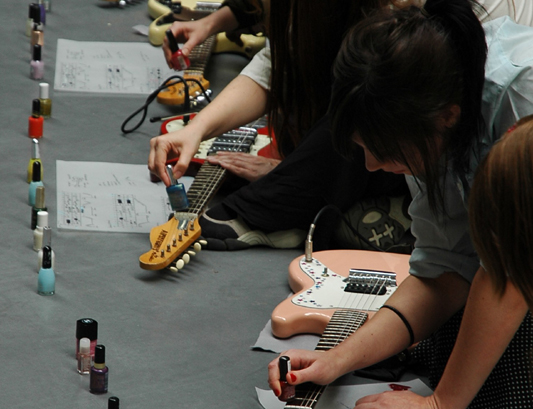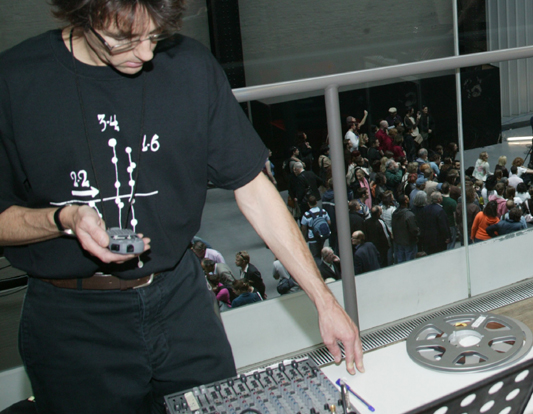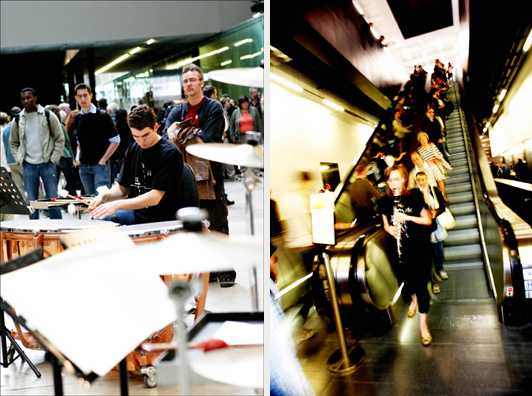ORIGINAL: Tate
Musicircus May 2006
John Cage (with Marina Rosenfeld and La Monte Young), Musical Direction: Richard Bernas
John Cage invented his Musicircus in 1967 for a performance in the Stock Pavilion at the University of Illinois at Urbana-Champaign. This three-hour performance is based on compositions principally by Cage and features live and pre-recorded electronics, as well as traditional instruments. Work by Marina Rosenfeld and La Monte Young were also included in this performance of Musicircus, directed by Richard Bernas, as the original versions of the score also included works by other composers.
From the late 1940s until his death in 1992, John Cage was a central figure in the American avant-garde. He is most commonly known for his silent composition 4'33" of 1952, whose three movements are performed at a piano without a single note being played.
Cage was an early composer of what he called 'chance composition' in music, a method that influenced the radical shift in modern dance initiated by his long-term partner and collaborator, Merce Cunningham, as well as influencing and working with visual artists such as Robert Rauschenberg, Andy Warhol and Jasper Johns. Cage was well known for his non-standard use of musical instruments and his pioneering exploration of electronic music.
Cage invented his Musicircus in 1967 for a performance in the Stock Pavilion at the University of Illinois at Urbana-Champaign. This three-hour performance is based on compositions principally by Cage and features live and pre-recorded electronics, as well as traditional instruments.
The performers in this version of Musicircus – arranged for Tate Modern by Richard Bernas – range from live electronic composer/performers, including Scanner and Robert Worby, to renowned new-music specialists, among them mezzo soprano Linda Hirst and the Kreutzer String Quartet. Young ensembles from the Guildhall School of Music and Drama and Goldsmiths College, and Marina Rosenfeld – leading her infamous electric-guitar ensemble, the Sheer Frost Orchestra – also perform.
Gramophone Award-winning conductor Richard Bernas collaborated closely with Cage, performing many world and European premieres with him.
 |
| Tate Modern; The Long Weekend; 28 May 2006; John Cage, Musicircus. Turbine Hall Bridge, Marina Rosenfeld and the Sheer Frost Orchestra © Tate 2006 |
DESCRIPTIONS OF ACTIVITIES AND LOCATIONS
TURBINE HALL
1. East end: The Guildhall Percussion Ensemble
John Cage: Atlas Eclipticalis (1961-62)
Originally commissioned by The New York Philharmonic, this score consists of no less than 86 separate parts, of which any number can be chosen. The material derives from astronomical star charts placed on grids to determine their pitch.
In this performance, all three of the tympani parts and two of the scores for unpitched percussion will be played.
2. West end: Scanner
John Cage: Fontana Mix (1958)
Cage was one of the pioneers of electronic music and the first to use vinyl discs as sources of sound, as opposed to records of performances, anticipating the activities of many creative DJs now. In Fontana Mix he made an indeterminate score of ten sheets of notations and 12 transparencies to be overlapped by random operations to produce a sound and time map. Composed when he was staying in Milan, Fontana Mix is named after Cage’s landlady.
Scanner’s realisation of Fontana Mix uses as its sound material popular music of the particular years relating to his favorite works in the Abstract collection and as such, bears a direct correlation with the Collection in a timeline of contemporary culture.
3. Bridge: Marina Rosenfeld and the Sheer Frost Orchestra
Marina Rosenfeld is the creator and director of the critically acclaimed orchestra, a 17-woman electric-guitar and nail-polish-bottle orchestra founded in 1994.
4. Musicians from Goldsmiths College Music Department
La Monte Young: Composition 1960 number 10
An early example of conceptual minimalism, Young’s instruction 'draw a straight line and follow it' will be realised by eight wind and brass players making slow trajectories from the bottom to the top of the building, using the escalators.
5. LKS Brass, Timothy Henty and James Young, conductors
This brass music is taken from a large-scale work, Apartment Building 1776, written for the US Bicentennial and designed to sound like an apartment building in 1776, had there been one. As with Atlas Eclipticalis, the performers are able to decide which parts of the whole range of materials to perform. This music is made of hymns composed in colonial America, erased and altered by means of chance operations derived from the I Ching. As is often the case with Cage’s work, the silences are as carefully constructed as the sounding pitches.
6. Levels 1 to 5 and the escalators
Four performers moving portable sound system
John Cage: Diary How to improve the world (you will only make matters worse). And Cage’s lectures on Jasper Johns, Marcel Duchamp and Robert Rauschenberg recorded at UCLA.
 |
| Tate Modern; The Long Weekend; 28 May 2006; John Cage, Musicircus. Level 3 entrance to Abstract Gallery; Langham Research Centre: Fontana Mix © Tate 2006 |
LEVEL 3 ABSTRACT GALLERY AND CONCOURSE
7. Kreutzer String Quartet: Peter Sheppard Skærved and Mihajlo Trandafilovski, violins; Morgan Goff, viola and Neil Heyde, cello
John Cage: String Quartet (1950) and Four (1989)
The String Quartet consists of four movements: Quietly flowing along; Slowly rocking; Nearly stationary; Quodlibet. It is a work of great simplicity, reminiscent of Erik Satie and in a way it is a further step towards the abandonment of self-expression. It deals with the Indian notion of the nine permanent emotions as well as about the Indian notion of the seasons, creation, preservation, destruction and quiescence. In the first movement the subject is summer in France, in the second it is fall in America. The third movement is about winter and the fourth about spring as a quodlibet. There is no overall score of Four, but four parts, each of which can be performed by any of the players. Every part consists of three five-minute sections (A, B and C), each with flexible time brackets and one fixed time bracket. In a performance, parts have to be exchanged and repeated by another player after finishing one or more sections.
8. Linda Hirst, mezzo-soprano
John Cage Aria (1958) and Song Books (1970)
Linda’s movements within the building are free; her time scale is decided from chance operations derived from the I-Ching.
9. Richard Benjafield percussion in the reading area
John Cage: Child of Tree and Lecture on Nothing
Child of Tree consists solely of performance instructions on how to select ten instruments, using I-Ching chance operations. 'All instruments are made of plant materials, or should be the plant materials themselves (e.g. leaves from trees, branches etc.). Using a stopwatch, the soloist improvises clarifying the time structure by means of the instruments. This improvisation is the performance.' (From performance instructions).
10. Public participation: Cage texts read from his first book, Silence (1961);
Lecture on Something; 45’ for a Speaker; Indeterminacy
11. Level 3 entrance to Abstract Gallery
Langham Research Centre: Robert Worby, Philip Tagney, Felix Carey and Iain Chambers
John Cage: Fontana Mix (1958)
Cage was one of the pioneers of electronic music both on tape and in his use of vinyl discs as sources of sound. He made an indeterminate score of ten sheets of notations and 12 transparencies to be overlapped by means of random operations in order to create a time and sound chart. The first realisation of these instructions was made on analogue tape at RAI Milan’s Studio di Fonologia (Italian Radio) and the work is named after Cage’s Milanese landlady, Signora Fontana.
The Langham Research Centre’s performance takes as its sonic starting point Cage’s original four mono tape tracks and subjects them to further chance operations derived from articulations of the score.


No comments:
Post a Comment